Laser
-
- A Step Forward For Thick Section Plate Cutting Maritime Reporter, Jun 2003 #77
For years, general manufacturing companies have enjoyed the benefit of laser cutting systems for producing complex or simple parts in batch volumes as low as one, and as high as tens of thousands.
The laser is an incredibly powerful tool that remains unsurpassed in manufacturing activities across the world. As flexible and reconfigurable production tool that provides welding, cutting and machining capabilities in a single device, lasers are readily automated and have demonstrated that they can easily operate in "lights-out" mode for even greater productivity. With all this said, why aren't there any laser shipyards?
Why hasn't one of the worlds largest and most important transportation industries rushed to implement laser cutting and welding technology? The answer is that the development of the state-of-the-art laser manufacturing technology has been a long and grueling process. Early lasers were just not powerful or reliable enough to attract an industry that had the capability to process heavy section metals using low cost and reliable technologies such as oxy-fuel and plasma cutting, with MIG and TIG and submerged arc techniques being the process of choice for welding. Even the Lloyds approval for laser welding of ship plates has yet to see lasers become commonplace in shipyards. The situation today is rather different. Lasers are now being employed commercially in thick plate cutting and welding and the industry has witnessed a quiet and rather successful processing revolution.
A new, and unexpected, breakthrough in the laser industry occurred in November 2002 at Bender Shipbuilding & Repair in Mobile, Ala. It was there that the first commercial use of the LASOX process cut through two in. of steel using a new cutting principle industrialized by Wayne Penn and his team from Alabama Laser. Co-developed by BOC Gases Ltd. and Dr. Bill O'Neill while working at the University of Liverpool, the LASOX process requires approximately 1 kW of laser power and uses oxygen to provide the cutting energy while the laser is used to maintain and stabilize a pre-heat - similar to the gas flame in oxy-fuel cutting.
With O'Neill and his team working on the thick section problem for more than a decade, commercial laser cutting has pushed the section limit from around 15 mm in 1990, to around 30 mm in 2003, with a subsequent increase in laser power from 2kW to 6kW. The process remains the same except the size of the process window is inversely proportional to the plate thickness. Prior to the invention of LASOX, it was a daunting process to cut pieces of high thickness.
As a result, there is always the temptation of turning up the power and the gas and just "letting it rip. While the LASOX process, however, will reportedly have the ability to produce the fastest scrap metal production system in the world, it will not, however, solve the problem of producing laser cuts up from 50-75 mm. "A year ago, cutting steel thicker than two inches would have been unheard of with a 2kW laser - one in.
being the maximum cutting depth undertaken commercially." said Pat Cahill, research and development manager for Bender Shipbuilding. "This process has the potential to cut steel plates as thick as four in. Currently highpowered plasma cutting is limited to three in. This development opens up the possibility of a new generation of steel ships that are stronger and cheaper to build." v With BOC Gases and the University of Liverpool providing the basic technology and process license for LASOX, Alabama Laser Systems carried out pre-production development of the lab based process and the integration into the existing laser cutting system at Bender Shipbuilding. The installation has been so successful that full installations at Caterpillar, for their heavy duty mining equipment; and General Dynamics - Electric Boat, for use in the building of submarines will be completed three months ahead of schedule.
In The Beginning LASOX cutting is the result of 13 years research by Dr. Jack Gabzdyl.
BOC's market development manager at the U.K.-based Fabrication Technology Center in Wolverhampton and Dr. Bill O'Neill formerly of the University of Liverpool, and now working at the Institute of Manufacturing at the University of Cambridge, UK. BOC Gases awarded O'Neill a Royal Society Industrial Research Fellowship to conduct a four-year study on laser cutting in 1990 - the outcome of his work being the LASOX process. O'Neill had been working on the thick section cutting problem by examining the dynamic effects of melt and gas flow through deep section kerfs and became convinced that the problem could be solved by forgetting the conventional laser cutting approach. "In 1990 the Holy Grail at that time was the ability to cut thick plate steel. In the early 1990s, laser cutting was very much limited to about 12 o 15 mm (0.48 to 0.6 in.). That's when we started looking at ways in which we could assist the thickness capability of laser cutting materials. We were quite convinced that the gas played a significant role," said Gabzdyl. So we turned the basic principles of laser cutting on its head, and looked to our expertise in oxy-fuel cutting where we realised hat the oxygen is really the process workhorse," he said.
He continued: "In traditional laser beam cutting, the laser is the workhorse while the oxygen assists in the process.
The oxygen just helps. We inverted that philosophy in laser cutting and made the oxygen jet the workhorse and the laser beam the assist." The LASOX cutting process is an exothermic burning reaction in which the heat of the laser beam is only used to bring the steel to ignition temperature at approximately 1,832°F (1,000° C). A specially designed nozzle is used to deliver a supersonic stream of oxygen to the heated spot, resulting in ignition and then sustained burning. LASOX combines the benefits of lasers and oxyfuel cutting by using a very modest amount of laser energy by conventional standards, about lkW, so the process can be operated with relatively small low cost lasers. This laser beam in effect replaces the fuel gas in oxy-fuel cutting. The laser beam is then combined with a high pressure supersonic oxygen gas jet, which provides the cutting energy.
Thicker material has traditionally been cut with oxyfuel and more recently with plasma torches but both processes suffer from quality issues. "When we started in the early 1990s, we would have been happy to cut one-in. steel plate. But as it happens, we've been able to cut increasingly thicker plate. By careful manipulation of the nozzle geometry and the beam chara c t e r i s t i c s , we can cut very thick material - up to about four in.
plate," said Gabzdyl.
Another advantage of LASOX is that it is instantaneous.
"There is no preheating element required to start the piercing process. In cutting two-in. steel with oxy-fuel, you ^ would need to put the flame on the surface for about 30 seconds before hitting the cutting oxygen jet to make the pierce. Whereas with the LASOX process, because the laser heats the surface instantaneously to the ignition temperature, as soon as you turn the laser on, you can turn on the gas stream and start piercing," explained Gabzdyl.
In January 2001, Gabzdyl and O'Neill were invited to present their findings on LASOX at a meeting at Caterpillar in Peoria, 111. "We turned everything on its head. We explained that the laser is not the important thing, it's actually the gas that does the trick. This astonished the laser community there, because they tend to be very laser-centric people who feel that the laser is always the most important thing," recalled Gabzdyl. "It definitely caught my eye," said Cahill, referring to the presentation. Later that evening, Gabzdyl, O'Neill, Cahill of Bender Shipbuilding and Penn of Alabama Lasers had discussions with the view to establishing this process in the shipbuilding industry.
In February 2001, Cahill pulled together the team of Bender Shipbuilding, Alabama Laser and BOC Gases, and wrote a proposal to the National Shipbuilding Research Program, (NSRP). "The proposal got selected and we moved forward. Less than a year after we started real work on it, we were using LASOX in production.
We went from the laboratory to production at almost lightning speed," said Cahill.
Penn, who serves as president of Alabama Laser agreed. "What we brought to the equation was taking LASOX out of the lab and making it work on the industrial floor. There's a big difference in doing something once in a lab and doing it a thousand times on the industrial floor," he said. "I've been working with lasers for 30 years and every now and then I see a quantum leap and LASOX fits into that category." Penn continued: "An important aspect of LASOX that isn't often mentioned is its ability to do intricate detail even on thick plate. We've been able to cut webs that just can't be achieved with other methods. The LASOX process supplies just enough heat to drive the reaction and a lot of that heat energy is removed through the kerf. Plasma cannot do the square cuts that allows you to do common line cutting with feature detail and a minimum heat for the part with a minimum amount of distortion, those features alone solve certain categories of problems. This is a tool to give you more capability, not a tool to displace other technologies. It gives someone that is going to invest a million dollars in a laser system with a new tool. It allows him to cut thicker plate without having to go out and buy a plasma or oxyfuel system and making a lot of redundancy and using up a lot more floor space." According to Pat Cahill of Bender, "LASOX is going to completely change the way people look at lasers as a cutting tool," said Cahill. "We're saving hours and hours of machine shop time because we're able to cut holes that are of machine quality. In the past we would cut the blanks out with an oxy-burner and take them to the machine shop and drill them." "LASOX has an almost zero kerf angle, an inch and a half material with less than one degree of a kerf angle. So you have a straight edge. It has almost no top edge melting at all." Turn to page 89 for updates on the latest Welding and Cutting Technologies
-
- Underwater Laser Scanning for Subsea Pipeline Inspection Marine Technology, Apr 2014 #42
Underwater Laser based micro-bathymetry is becoming a new standard for subsea pipeline and asset inspection. As the industry moves to deeper and more hostile environments for extraction of oil, technology to manage the risks involved in these environments are critical. This became most evident during the
-
- Next-Generation Subsea Metrology: Better Measurements, Fast Marine Technology, Mar 2017 #52
Centre in Fort William. The event was organized by DOF Subsea to showcase the capabilities of dynamic mobile mapping. The new technique uses a 3D laser scanner fitted to an ROV to create highly detailed, point cloud images of subsea assets and environments. By combining the 3D laser data with precise
-
- Clean Technology Lasers: A New Tool to Remove Corrosion and Scale Marine News, Aug 2023 #40
Laser systems quickly remove corrosion and scale from metal surfaces with less preparation and mess than traditional techniques.In the maritime industry, corrosion and scale (where rust penetrates a metal surface) can quickly become an issue in an outdoor, salt sea spray laden environment. When sea spray
-
- Hypertherm Enters Laser Cutting Market Maritime Reporter, Nov 2003 #81
FAST Laser (Flow Accelerated Screen Technology) from Hypertherm, Inc. is a new platelaser cutting technology from Hypertherm, a company that has been a leader in the advancement of plasma cutting technology for over 35 years. FAST Laser technology broadens the company's technology leadership position
-
- Report On Laser Technology Made To ASNE Long-Beach-Greater L.A. Section Maritime Reporter, Nov 15, 1981 #58
, welcomed the 57 members and guests. Chairman Gildea next introduced the speaker for the evening, Capt. Alfred Skolnick, USN, whose topic was "Laser Development and Application to the U.S. Navy." Captain Skolnick is project manager of High Energy Lasers, P.M. 22, of the Naval Sea Systems Command
-
- 3D Laser Scanning for the Marine Industry Maritime Logistics Professional, Q4 2013 #46
FARO 3D laser scanning allows the Chief Engineer or Project Manager to work in detail with 3D model shots of machinery spaces with increased accuracy and reduced costs. The time to install a Ballast Water Treatment (BWT) System or maybe an Exhaust Gas Scrubber is rapidly approaching. Or, perhaps, you are
-
- New FARO Laser Scanner Focus3D X 33 Maritime Reporter, Feb 2014 #58
FARO Technologies released the FARO Laser Scanner Focus3D X 330. With a range almost three times greater than previous models, the Focus3D X 330 can scan objects up to 330m away and in direct sunlight. With its integrated GPS receiver, the laser scanner is able to correlate individual scans in post-processing
-
- FARO Debuts X Series Laser Scanner Maritime Reporter, Apr 2014 #103
FARO Technologies, Inc. released the new FARO Laser Scanner Focus3D X 130, the newest member of Focus3D X Series range of laser scanners. With a scanning range of 130m, this laser scanner is suited for mid-range scanning applications. The portable Focus3D X 130 enables fast, straightforward and accurate
-
- Provide Solutions Introduces 3D Laser Scanning Maritime Reporter, Oct 2003 #56
LIDAR-based 3D laser scanning allows designers and builders to view structural and machinery units already fit as a final product before construction and assembly are finished. Quick dimensional comparison can be made between drawings and constructed units, checks for accuracy and alignment can be
-
- Keeping Machinery in Line with Laser Alignment Maritime Reporter, Aug 2014 #38
, which is why pre-and post-hull deflection measurements are crucial for proper alignments. AME uses the Levalign Ultra, a self-leveling rotating laser system to conduct this procedure which is vital to successful haul-outs. Likewise, a final laser alignment check should be done oncethe vessel has
-
- Fugro High Res Subsea Laser Scanning Marine Technology, Dec 2014 #56
Fugro expanded its services for the offshore oil and gas sector with the addition of high resolution subsea laser scanning specialist technology that can be applied to a wide range of subsea services including metrology, field mapping, structure mapping, change detection and integrity management. Fugro’s
-
 )
March 2024 - Marine Technology Reporter page: 44
)
March 2024 - Marine Technology Reporter page: 44the HIPS & SIPS 12 release, with Featured were Optech CL-360 Marine, a 360-degree long- new work? ows for multiple frequency datasets and creating/ range laser scanner combining a scan speed of 250 lines per managing vessel ? les. second with 2 mm range resolution, a plug & play solution, and an IP67 marine
-
 )
March 2024 - Marine Technology Reporter page: 11
)
March 2024 - Marine Technology Reporter page: 11from standoff range to scan the seabed using high resolution underwater imaging systems, including sidescan and synthetic aperture sonars, as well as laser scanners. Ukraine is al- ready in possession of six Remus 100 AUVs provided by the Royal Navy for MCM purposes, but a multinational mine clearance
-
 )
March 2024 - Marine Technology Reporter page: 9
)
March 2024 - Marine Technology Reporter page: 9from marinas along the western coast. The exact number of lizing laser detection systems can detect mines just below the mines, as well as their locations, remains largely a mystery, surface, even those hiding in murky water. The Airborne Laser although reports suggest that over three hundred have been
-
 )
February 2024 - Maritime Reporter and Engineering News page: 44
)
February 2024 - Maritime Reporter and Engineering News page: 44services. Recently a monitoring techniques. team carried out a job taking place in Canada for a cargo ship. The task was greeninstruments.com on-site laser measurement of the rudder line and on-site machining of the rud- GE Vernova der horn casting. MarineShaft delivered justing the number of installed
-
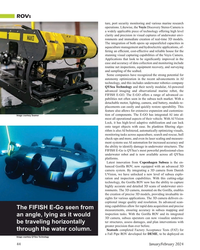 )
January 2024 - Marine Technology Reporter page: 44
)
January 2024 - Marine Technology Reporter page: 44is also AI bolstered, automatically optimizing visuals, monitoring tasks across aquaculture, search and rescue, hull check-ups and more, and even its laser scaling and measure- ment systems use AI automation for increased accuracy and the ability to identify damage in underwater structures. The FIFISH
-
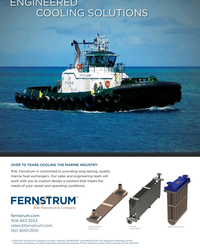 )
January 2024 - Maritime Reporter and Engineering News page: 4th Cover
)
January 2024 - Maritime Reporter and Engineering News page: 4th Coverthat meets the needs of your vessel and operating conditions. fernstrum.com 906.863.5553 ® ® [email protected] Omega GRIDCOOLER WEKA Boxcooler Laser Plate™ Keel Cooler ISO 9001:2015 © 2024 R.W. Fernstrum & Company. All rights reserved. FERNSTRUM® and GRIDCOOLER® are registered trademarks of R.W
-
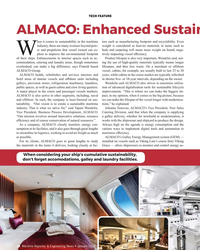 )
January 2024 - Maritime Reporter and Engineering News page: 38
)
January 2024 - Maritime Reporter and Engineering News page: 38is also active in other segments, including, naval pact, in my opinion, when it comes to the big picture, because and offshore. In each, the company is laser-focused on sus- we can make the lifespan of the vessel longer with moderniza- tainability. “Our vision is to create a sustainable maritime tions
-
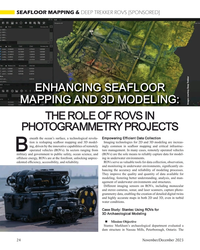 )
November 2023 - Marine Technology Reporter page: 24
)
November 2023 - Marine Technology Reporter page: 24, and man- agement of underwater environments and structures. Different imaging sensors on ROVs, including monocular and stereo cameras, sonar, and laser scanners, capture photo- grammetry data, enabling the creation of detailed digital twins and highly accurate maps in both 2D and 3D, even in turbid
-
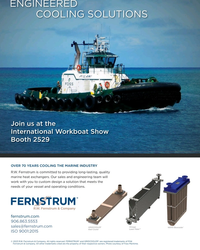 )
November 2023 - Maritime Reporter and Engineering News page: 4th Cover
)
November 2023 - Maritime Reporter and Engineering News page: 4th Coverthat meets the needs of your vessel and operating conditions. fernstrum.com 906.863.5553 ® ® [email protected] Omega GRIDCOOLER WEKA Boxcooler Laser Plate™ Keel Cooler ISO 9001:2015 © 2023 R.W. Fernstrum & Company. All rights reserved. FERNSTRUM® and GRIDCOOLER® are registered trademarks of R.W
-
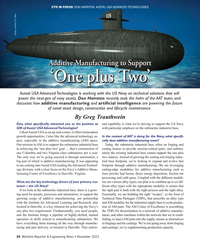 )
November 2023 - Maritime Reporter and Engineering News page: 24
)
November 2023 - Maritime Reporter and Engineering News page: 24focus on the Navy’s Additive Manu- cutting-edge modalities for additive manufacturing such as facturing Center of Excellence in Danville, Virginia. laser powder bed fusion, direct energy deposition, friction stir processing and cold spray. Coupled with the different modali- What are the key technology
-
 )
September 2023 - Marine Technology Reporter page: 76
)
September 2023 - Marine Technology Reporter page: 76lighting enable real-time system control and component of this system comprises two feedback from the heart of every subsys- ViperFish torch lights with lasers and a tem. Its robotic systems range from the low power-draw. top-rated and highly-portable Falcon, to its newest deep-rated work system SEAFLOOR
-
 )
September 2023 - Marine Technology Reporter page: 60
)
September 2023 - Marine Technology Reporter page: 60The this purpose, the vehicle is equipped with a variety of sensors CleanSeas project, funded by the German Federal Ministry of such as sonars, cameras, laser scanners and magnetometers. Education and Research (BMBF) until December 31, 2025, The technologies developed will initially be tested under aims
-
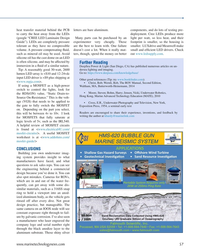 )
September 2023 - Marine Technology Reporter page: 57
)
September 2023 - Marine Technology Reporter page: 57Reclamation Data Collected Using HMS-620 ure by galvanic corrosion. I’ve also seen Courtesy URI Graduate School of Oceanography a manufacturer who laser engraved the Falmouth Scienti¿ c, Inc. company logo and serial number right Pocasset, MA USA 02559 • Tel: +1-508-564-7640 • Fax: +1-508-564-7643
-
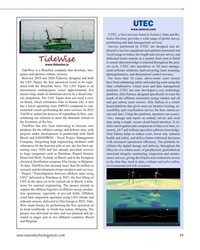 )
September 2023 - Marine Technology Reporter page: 49
)
September 2023 - Marine Technology Reporter page: 49.io ect cycle. UTEC also specializes in 3D asset manage- TideWise is a Brazilian company that develops, inte- ment software solutions, land surveying, laser scanning, grates and operates robotic systems. photogrammetry, and dimensional control services. Between 2019 and 2020 Tidewise designed and built
-
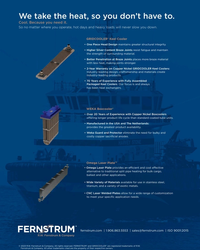 )
August 2023 - Maritime Reporter and Engineering News page: 4th Cover
)
August 2023 - Maritime Reporter and Engineering News page: 4th Coverprovides the greatest product availability. • Weka Guard and Protector eliminate the need for bulky and costly copper sacri?cial anodes. Omega Laser Plate™ • Omega Laser Plate provides an efcient and cost efective alternative to traditional split pipe heating for bulk cargo, ballast and
-
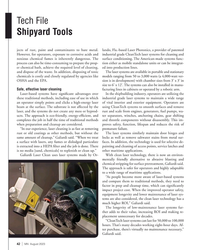 )
August 2023 - Marine News page: 42
)
August 2023 - Marine News page: 42Tech File Shipyard Tools jects of rust, paint and contaminants to bare metal. lando, Fla.-based Laser Photonics, a provider of patented However, for operators, exposure to corrosive acids and industrial grade CleanTech laser systems for cleaning and noxious chemical fumes is inherently dangerous.
-
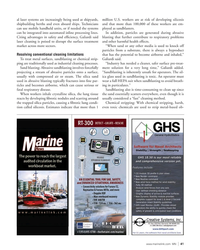 )
August 2023 - Marine News page: 41
)
August 2023 - Marine News page: 41al laser systems are increasingly being used at shipyards, million U.S. workers are at risk of developing silicosis shipbuilding berths and even aboard ships. Technicians and that more than 100,000 of these workers are em- can use mobile handheld units, or if needed the systems ployed as sandblasters.
-
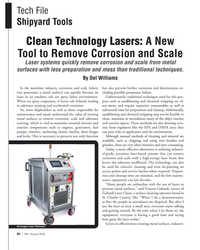 )
August 2023 - Marine News page: 40
)
August 2023 - Marine News page: 40Tech File Shipyard Tools Clean Technology Lasers: A New Tool to Remove Corrosion and Scale Laser systems quickly remove corrosion and scale from metal surfaces with less preparation and mess than traditional techniques. By Del Williams In the maritime industry, corrosion and scale (where but also
-
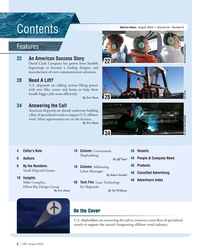 )
August 2023 - Marine News page: 2
)
August 2023 - Marine News page: 2Labor Shortages 46 Classi? ed Advertising By Robert Kunkel 10 Insights: 48 Advertisers Index Mike Complita, 40 Tech File: Laser Technology Elliott Bay Design Group for Shipyards By Eric Haun By Del Williams On the Cover U.S. shipbuilders are answering the call
-
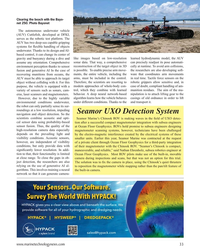 )
July 2023 - Marine Technology Reporter page: 33
)
July 2023 - Marine Technology Reporter page: 33, compliant handling of am- variety of sensors such as sonars, cam- trol, which they combine with learned munition residues. The aim of the ma- eras, laser scanners and magnetometers. behavior. A deep neural network-based nipulation is to attach lifting gear to the However, due to the highly variable
-
 )
July 2023 - Marine Technology Reporter page: 16
)
July 2023 - Marine Technology Reporter page: 16to work hardening. CASTING AND 3D PRINTING Casting of titanium parts is done in an inert atmosphere for MACHINING AND FABRICATION reasons noted above. Laser sintering of titanium has been Titanium fabrication requires an appreciation for the unique shown as a practical 3D print process, but also requires
-
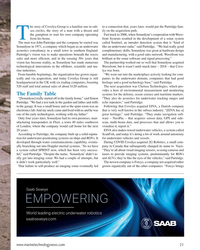 )
May 2023 - Marine Technology Reporter page: 21
)
May 2023 - Marine Technology Reporter page: 21has been very success- “They’re all about visual imaging sensors, so using cameras and ful,” said Partridge. “Despite the name, ‘Sonardyne’ didn’t re- lasers to provide imaging systems, predominantly for ROVs ally get into imaging sonar. We had a couple of attempts, but and AUVs; they’re like the eyes
-
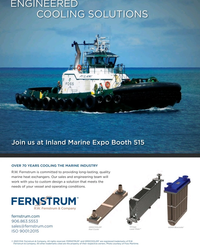 )
May 2023 - Maritime Reporter and Engineering News page: 4th Cover
)
May 2023 - Maritime Reporter and Engineering News page: 4th Coverthat meets the needs of your vessel and operating conditions. fernstrum.com 906.863.5553 ® ® [email protected] Omega GRIDCOOLER WEKA Boxcooler Laser Plate™ Keel Cooler ISO 9001:2015 © 2023 R.W. Fernstrum & Company. All rights reserved. FERNSTRUM® and GRIDCOOLER® are registered trademarks of R.W
-
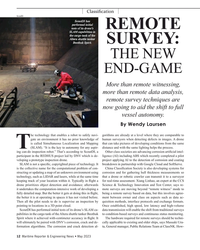 )
May 2023 - Maritime Reporter and Engineering News page: 12
)
May 2023 - Maritime Reporter and Engineering News page: 12for structing or updating a map of an unknown environment using corrosion and for gathering hull thickness measurements so technology, such as LIDAR and lasers, while at the same time that a drone or robotic crawler can transmit it to a surveyor keeping track of your location within it. Typically in ?
